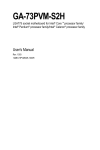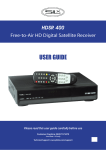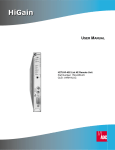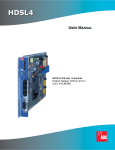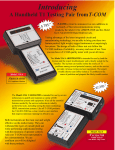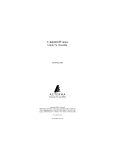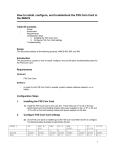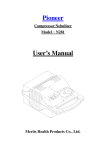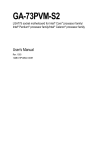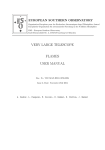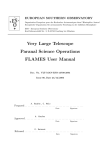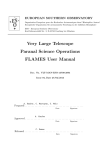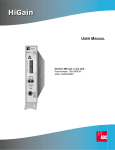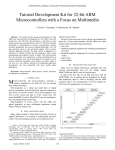Download ELECTRODATA T1 Lite
Transcript
P/N 610062 REV D TABLE OF CONTENTS 1.0 INTRODUCTION 1.1 1.2 1.3 1.4 2.0 DESCRIPTION 2.1 2.1.1 2.1.2 2.1.3 2.1.4 2.2 2.2.1 2.2.2 3.0 Overview .....................................................................................1 Accessories ..................................................................................2 Assistance ....................................................................................2 Specifications ..............................................................................3 Controls and Indicators ...............................................................5 Test Set Controls .........................................................................5 Green LED Status Indicators.......................................................6 Red LED Status Indicators ..........................................................7 Connector Jacks...........................................................................8 Display.........................................................................................8 SETUP Menu...............................................................................8 RESULTS Menu........................................................................10 OPERATION 3.1 3.2 3.2.1 3.2.2 3.3 3.4 3.5 3.5.1 3.5.2 3.5.3 3.5.4 3.5.5 3.5.6 3.5.7 Instrument Power Up ................................................................13 Setup ..........................................................................................13 Autoconfiguration......................................................................13 Manual Configuration ...............................................................14 Monitoring a T1 Line ................................................................14 Loopback Operations ................................................................15 Testing the Line .........................................................................16 Transmitting a Test Pattern........................................................17 Injecting Errors into the Data Stream .......................................17 Scanning for Active DS0 Channels ..........................................18 Measuring Clock Slips ..............................................................19 Drop and Insert Testing .............................................................20 Setting Signaling Bits................................................................21 NIU/CSU Emulation .................................................................22 TABLE OF CONTENTS (Continued) 4.0 MAINTENANCE 4.1 4.2 4.3 4.4 5.0 Routine Maintenance.................................................................25 Battery / AC Operation .............................................................25 Battery Replacement .................................................................26 Self-Test Procedure ...................................................................27 WARRANTY ..........................................................................................27 LIST OF TABLES Table 1. T1-LITE Accessories..............................................................................2 © 2000-2003 Electrodata, Inc. T1-LITE Transmission Test Set 1.0 INTRODUCTION 1.1 Overview The T1-LITE® transmission test set is an extremely light weight, hand-held T1 transmission test set designed for quick, but thorough, T1 circuit testing for installation, maintenance, or service verification. It can be powered from a 115/230 VAC battery eliminator/charger or from a set of internal rechargeable nickel cadmium batteries. The T1-LITE is designed to be set up quickly and has the following characteristics: a. Autoconfigures to the line code, framing, and test pattern b. Generates standard loopback commands to control far end devices c. Transmits nine standard industry T1 test patterns plus digital milliwatt and voice data d. Sets AB or ABCD signaling bits e. Allows aural monitoring of T1 line or DS0 channel data through a front panel speaker or headset jack f. Using thirteen front panel LEDs, automatically displays the presence of pulses, frame and pattern synchronization, presence of B8ZS codes, signal loss, ALL1’s, low ones density, bipolar violations (BPV), errors present, presence of yellow alarm, DS1 idle signal, and excess zeros g. LCD display shows: error summary, BPV errors, bit errors, frame errors, CRC errors, error free seconds, errored seconds, receive frequency, T1 receive level, channel frequency and level, channel number and data, status of signaling bits, clock slips, frame slips, and elapsed time. 1 1.2 Accessories The T1-LITE is shipped with a PS-3 Battery Eliminator/Charger and a user manual. Test cables should be ordered seperately to match your particular connection requirements. Refer to Table 1, T1-LITE Accessories, for a list of additional accessories available at added cost. Table 1. T1-LITE Accessories Part Number 140089 600041 600042 600049 600053 600058 600059 610062 630048 TAU-1 Description Soft Pack Carrying Case Bantam to Bantam Patch Cord (5’) Bantam to 310 Adapter Bantam to Alligator Test Cable (6’) Station Protector to Dual Bantam Test Cable (6’) Bantam to Wire-Wrap Post (Slip-on) Dual Bantam to RJ48 Test Cable Bantam to BNC Test Cable - 75 ohm (6’) RE-1 Repeater Extender Tau 1 Test Access Unit 1.3 Assistance For technical assistance, please call Electrodata at (216) 663-3333 or toll free (800) 441-6336 between the hours of 7:00 a.m. and 5:00 p.m. EST, Monday through Friday, or e-mail to [email protected]. 2 1.4 Specifications for the T1-LITE Electrical Interface Connectors: RX, TX, REF Headset Bantam jacks Accepts standard 2.5mm mobile phone headset Output Input Clock Pulse Shape Conforms to ITU-T recommendation G.703; AT&T Publications CB113, CB119, CB132, CB143, PUB62508, and PUB62411 pulse shape specifications when terminated in 100 ohms and 0 dB Line Buildout is selected. Line Buildout Line Code 0 dB, -7.5 dB, -15 dB AMI, B8ZS Terminate Monitor Bridge DSX +6 dB to DSX -36 dB, 100 ohms DSX -14 dB to DSX -36 dB, 100 ohms DSX +6 dB to DSX -36 dB, >1000 ohms Internal External Recovered 1.544 MHz ±5 ppm ±300 ppm ±300 ppm Transmitter and Receiver Framing Formats Channel Formats Unframed, D3/D4, ESF, SLC96* 64x1 or Full T1 Test Patterns QRSS, 55 Octet, T1-Daly, All 1’s, 3 in 24, 2 in 8, 1:7, Alternating 1/0, All 0’s Error Injection Type Alarms Detected BPV, CRC, Frame, Bit LOS, Yellow, AIS, Idle 3 Loop-Back Capability NIU, NET-NIU, CSU, HDSL-T1E1.4, PAIRGAINGNLB DS0 Specifications VF In/Out Connector 2.5mm headset jack Power Batteries: Battery Life: Recharge Time: AC Operation: Rechargeable AA nickel cadmium (qty 4) 4 hours nominal per charge 6 hours typical Selectable 115/230 VAC, 50/60Hz (PS-3) Physical Display: 2 line by 16 character Size: 5.5”L x 3.75”W x 2.5”H Weight: .6 Kgram (1 lb. 5 oz.) Operating Temperature: Storage Temperature: Humidity: -20° C to +60° C -30° C to +80° C 10% to 90% non-condensing Measurements Errors: Errored Seconds and Time: BPV, Bit, Frame,CRC, Bit Error Rate Errored seconds, Percent errored seconds, Error free seconds, Percent error free seconds, Elapsed time T1 and Channel: Receive frequency and level, DS0 channel number and data, DS0 channel signaling, DS0 channel frequency and level, A, B, C or D signaling all 24 channels 4 2.0 DESCRIPTION 2.1 Controls and Indicators The T1-LITE is operated with two slide switches, a twelve-button keypad, thirteen LEDs, and five connector jacks. All controls and indicators are explained in the following paragraphs: 2.1.1 Test Set Controls POWER Two-position slide switch controls battery or external d.c. operating power to the test set. TERMINATION Three position slide switch sets the impedance of the RX input. TERM Used when the test set terminates the T1 circuit. MON Used when the test set RX jack is connected to a DSX MON jack. BRDG Used when the test set is connected across an active T1 circuit. VOLUME Used with the arrow keys to adjust the speaker and headset volume. AUTO CONFIG Initiates and automatic configuration of the test set to the circuit framing, line code, and test pattern if present. LOOP UP Causes the test set to transmit a loop up command to a local or remote device. LOOP DOWN Causes the test set to transmit a loop down command to a local or remote device. CHANNEL Allows user to select a specific DS0 for testing or monitoring. 5 SETUP Changes the current display to the SETUP menu. Pressing SETUP while in the SETUP menu returns the display to the top of the SETUP menu. EDIT Enables changing a variable parameter shown on the display. RESULTS Changes the current display to the RESULTS menu. Pressing RESULTS while in the RESULTS menu returns the display to the top of the RESULTS menu. ERROR Used to insert a CRC error, frame error, bit error, or BPV into the transmit data stream. When held down, the test set transmits four errors per second. RESTART Clears previous test results and initiates a new test cycle. Arrow Keys Used to step up and down through menu selections or to increase or decrease variable shown on the display. 2.1.2 Green LED Status Indicators PULSES Lights when a T1/D1 signal is present at the RX jack. FRAME SYNC Lights when the test set synchronizes with the framing format of the DS1 signal. Flashes if synchronization has been lost and restored during a test. PATTERN SYNC Lights when the test set synchronizes with a DS1 test pattern, Flashes if synchronization has been lost and restored during a test. B8ZS Lights when a B8ZS code is received and flashes to provide B8ZS line coding indication in absence of continuing codes. 6 2.1.3 Red LED Status Indicators BATTERY LOW Lights when battery requires recharging. NOTE: Operation becomes unstable when this lamp is illuminated. Continue operation using the PS-3 battery eliminator/charger. SIGNAL LOSS Lights if the T1 signal is lost during a test. DS1 IDLE Lights if the test set detects a DS1 idle code present on the line. Begins to flash if the idle signal is no longer present. ALL 1’S Lights when an UNFRAMED All 1's (AIS or Blue Alarm) DS1 signal is received. Begins to flash if the UNFRAMED All 1's signal goes away (Signal is used to maintain transmission continuity when a service interruption has occurred.) ONES DENSITY Lights if a DS1 signal averages less than 12.5% ones during a one second period. Flashes if a low ONES DENSITY signal is present, then removed during a test. BPV Lights when a bipolar violation is detected on the receive signal. Begins to flash when the BPV is no longer present. ERRORS Lights when the test set detects a BPV, frame, CRC, or pattern error. Begins to flash when the BPV, frame, or pattern errors are no longer present. YELLOW ALARM Lights when YELLOW ALARM signal is detected.Begins to flash if the YELLOW ALARM is no longer present. 7 EXCESS ZEROS Indicates that 16 or more zeros have been received when AMI encoding has been selected or that eight or more zeros have been received when B8ZS encoding has been selected. Begins to flash when the EXCESS ZEROS condition is no longer present. 2.1.4 Connector Jacks Power Jack Connection point for PS-3 Battery Eliminator/ Charger. TX Jack Bantam ring/tip connection point to T1 transmit line. REF Jack Bantam ring/tip connection point to T1 reference clock. RX Jack Bantam ring/tip connection point to T1 receive line Earphone Jack Audio input/output jack for microphone headset 2.2 DISPLAY The primary display of the T1-LITE is a two-line LCD display. The top line names the parameter and the bottom line displays the value or setting. The control keys described in paragraph 2.1.1 determine the parameter displayed in the "window" and adjust the contents of the second line when appropriate. Paragraph 2.2.1 lists the test parameters and selections that must be addressed while setting up the test set prior to testing. The left column lists the parameters and the right column shows the selections for each parameter. Paragraph 2.2.2 lists the types of events, measurements, and data presented on the display during or after a test cycle. 2.2.1 SETUP Menu The settings shown in bold typeface are default settings automatically selected if POWER is turned on while holding down the SETUP key. 8 TRANSMIT LBO 0 dB, -715 dB, -15, dB LINE CODING B8ZS, AMI FRAMING FORMAT ESF, D3/D4, SLC-96, UNFRAMED CHANNEL FORMAT FULL T1, 64 X 1 PATTERN QRSS, HEADSET, DIGITAL MILLIWAT, IDLE, 55OCTET, T1-DALY, ALL 1’S, 3 IN 24, 2 IN 8, 1:7, ALTERNATING 1/0, ALL ZERO’S TRANS SIGNALING 1 or 0 for each signaling bit (Active only when CHANNEL FORMAT is set to 64X1 and PATTERN is set to IDLE, DIGITAL MILLIWAT, or HEADSET) FILL DATA IDLE, LOOP (Active only when CHANNEL FORMAT is set to 64 X 1) TRANS CLK SOURCE INTERNAL, DS1 REFERENCE, RECOVERED CLOCK REFERENCE NONE, REF. INPUT, INTERNAL ERROR INSERT BPV, CRC, FRAME, BIT LOOP CODE TYPE NIU/CSU, HDSL-T1E1.4, PAIRGAIN-GNLB LOOP CODE NIU, NET-NIU, CSU, NI, HRU HDU4, HDU3, HDU2, HDU1, HLU, SMJK, CREM, CDU4, CDU3, CDU2, CDU1, CLOC, NREM, NDU4, NDU3, NDU2, NDU1, NLOC 9 ESF LOOP CODE DATALINK, IN-BAND CSU/NIU EMULATE DISABLED, ENABLED AUDIBLE ALARM OFF, ON ALARM LEVEL (Hold down the EDIT key and use the arrow keys to increase or decrease level) DISPLAY CONTRAST (Hold down the EDIT key and use the arrow keys to increase or decrease contrast) 2.2.2. RESULTS Menu When monitoring or testing a T1 circuit and the RESTART key has been pressed to begin a test cycle, the display will report “ERROR SUMMARY, NO ERRORS” if the circuit conditions are normal. When an abnormal condition or event occurs, the display will report “ ERROR SUMMARY” on the first line while the names of specific events cycle on the second line. By pressing the arrow keys, the display will step through the RESULTS menu one item at a time. Pressing the RESULTS key will cause the display to cycle through the abnormal events again. ERROR SUMMARY Screen reports all errors detected during the current test cycle. If more than one type of error occurs, the second line cycles through each error type. BPV ERRORS Bipolar violation errors are a count of improperly encoded bits in the received data. BIT ERRORS Bit errors are the number of data errors detected in the received data pattern. Errors will only be counted when the PATTERN SYNC lamp is on. 10 is present on the line. When the autoconfiguration routine is complete, the test set TX output will match the T1 framing format and line code present during the operation. To Perform an Autoconfiguration: 1. Turn on the test set. 2. Set the TERMINATION switch to match the type of connection required. 3. Connect the test set RX jack to the line to be tested. 4. Press the test set AUTO CONFIG key. 3.2.2 Manual Configuration To perform a manual configuration, set the LINE CODE and FRAMING FORMAT using the procedure shown in paragraph 3.2, Setup. BIT ERROR RATE FRAME ERRORS Frame errors are the number of frame bit errors detected in the receive signal. Errors will only be counted while the FRAME SYNC lamp is on. CRC ERRORS CRC errors are the number of incorrect ESF or SLC-96 cyclic redundancy checks received. Errors will only be counted when ESF or SLC-96 framing is selected and the FRAME SYNC lamp is on. ERROR FREE SEC Error free seconds are the number and percentage of one second intervals which were free of errors. ERRORED SEC Errored seconds are the number and percentage of one second intervals which contain one or more BIT, BPV, FRAME, or CRC errors or during which PATTERN SYNC, FRAME SYNC, or SIGNAL PRESENT indications are lost. RECV FREQUENCY T1 received frequency recovered from the input data stream and averaged over a 10 second interval. T1 RECEIVE LEVEL T1 receive level in dBdsx or volts peak-to-peak. Hold EDIT and use the arrow keys to modify the units displayed. (For best accuracy, use the TERM input impedance and an ALL 1's input pattern. 3.3 Monitoring a T1 Line Monitoring the line allows the user to make basic measurements such as receive frequency and level, and to watch for specific events such as changing signaling bits, or the presence of alarms or errors, without disturbing the normal line traffic. To Perform a Monitoring Operation: 1. Turn on the test set. 2. Set the TERMINATION switch to MON if the test set is to be connected to a T1 MONITOR jack; to TERM if the test set is to be connected to a line OUTPUT jack; or BRDG if connected directly to a line conductor. 14 Total number of BIT ERRORS divided by the total number of data bits received. This measurement requires that the PATTERN SYNC lamp is on. CH.FREQ/LEVEL The frequency and level of the tone in the currently selected DS0 channel. Available only when CHANNEL FORMAT is set to 64 X 1. CH. NUMBER/ DATA The currently selected DS0 channel and the data contents of that channel. Available only when CHANNEL FORMAT is set to 64 X 1. 11 CH. SIGNALING The detected signaling bits for the currently selected DS0 channel. The display shows A and B, or A, B, C, and D depending on the framing format of the signal. A/B/C/D BIT SIGNALING The detected signaling bits for all DS0 channels in the T1 data stream. Channels 1 to 12 are displayed above channels 13 to 24 and both are displayed from left to right with a 1/0 value. A, B, C, and D bits must be selected separately. CLOCK SLIPS Difference between the receive signal timing and an the test set's internal clock or an external clock connected to the REF jack. Available only when CLOCK REFERENCE is set to INTERNAL or REF. INPUT. FRAME SLIPS Frame slip occurs as a result of 193 accumulated clock slips in the same direction (positive or negative). Available only when CLOCK REFERENCE is set to INTERNAL or REF. INPUT. 3.0 OPERATION 3.1 Instrument Power Up Turn on the T1-LITE by setting the POWER switch to the ON position. After power is turned on, the instrument speaker will beep twice, the screen will display ERROR SUMMARY NO ERRORS, and individual LED lamps may be on or off depending upon current settings and connections. 3.2 Setup The T1-LITE has fifteen selectable parameters that may be chosen and manually set to meet the operational requirements of the T1 line to be tested and the test set output requirements dictated by the test to be run. To Perform a Setup: ELAPSED TIME HH:MM:SS test time interval since the last RESET 1. Turn on the test set. 2. Press the SETUP key to begin the setup procedure. 3. Use the arrow keys to move through the selection of parameters listed in Table 6, SETUP Menu . For each item to be changed, hold down the EDIT key and use the arrow keys to view the possible settings for each item. The last setting displayed before moving to the next item is the one selected. 3.2.1 Autoconfiguration The T1-LITE will execute an autoconfiguration routine whenever the RX jack is connected to a T1 signal source and the AUTOCONFIG switch is pressed. During autoconfiguration, the test set will automatically detect and display the LINE CODE, FRAMING FORMAT, and TEST PATTERN if one 12 13 3.0 OPERATION 3.1 Instrument Power Up Turn on the T1-LITE by setting the POWER switch to the ON position. After power is turned on, the instrument speaker will beep twice, the screen will display ERROR SUMMARY NO ERRORS, and individual LED lamps may be on or off depending upon current settings and connections. 3.2 Setup The T1-LITE has fifteen selectable parameters that may be chosen and manually set to meet the operational requirements of the T1 line to be tested and the test set output requirements dictated by the test to be run. To Perform a Setup: 1. Turn on the test set. 2. Press the SETUP key to begin the setup procedure. 3. Use the arrow keys to move through the selection of parameters listed in Table 6, SETUP Menu . For each item to be changed, hold down the EDIT key and use the arrow keys to view the possible settings for each item. The last setting displayed before moving to the next item is the one selected. 3.2.1 Autoconfiguration The T1-LITE will execute an autoconfiguration routine whenever the RX jack is connected to a T1 signal source and the AUTOCONFIG switch is pressed. During autoconfiguration, the test set will automatically detect and display the LINE CODE, FRAMING FORMAT, and TEST PATTERN if one 13 is present on the line. When the autoconfiguration routine is complete, the test set TX output will match the T1 framing format and line code present during the operation. To Perform an Autoconfiguration: 1. Turn on the test set. 2. Set the TERMINATION switch to match the type of connection required. 3. Connect the test set RX jack to the line to be tested. 4. Press the test set AUTO CONFIG key. 3.2.2 Manual Configuration To perform a manual configuration, set the LINE CODE and FRAMING FORMAT using the procedure shown in paragraph 3.2, Setup. 3.3 Monitoring a T1 Line Monitoring the line allows the user to make basic measurements such as receive frequency and level, and to watch for specific events such as changing signaling bits, or the presence of alarms or errors, without disturbing the normal line traffic. To Perform a Monitoring Operation: 1. Turn on the test set. 2. Set the TERMINATION switch to MON if the test set is to be connected to a T1 MONITOR jack; to TERM if the test set is to be connected to a line OUTPUT jack; or BRDG if connected directly to a line conductor. 14 3. Connect the test set RX jack to the line under test. 4. Press the AUTOCONFIG key. The test set will autoconfigure to the line under test. When the screen has completed the autoconfiguration sequence, the displayed screen will change to the display shown prior to the autoconfiguration operation. 5. Use the arrow keys to step through all the display parameters. Any red LED indicates an abnormal condition of the line. If the ERRORS lamp is lit, the ERROR SUMMARY screen will display the type of error detected. Any blinking lamp indicates a change has occurred for that indicator since the start of the test. 6. To clear the test set of error and alarm indications, press the RESTART key. 3.4 Loopback Operations Looping a T1 span back on itself provides an easy way to run many tests from a single end of the line using only the T1-LITE. The T1-LITE will perform looping operations on three types of circuits: NIU/CSU, HDSLT1E1.4, and PAIRGAIN-GNLB. To Perform a Looping Operation: 1. 2. 3. 4. Turn on the test set and configure it for the line to be tested. Perform the setup procedure shown in paragraph 3.2 SETUP. Use the arrow key to display the LOOP CODE TYPE screen. Press and hold the EDIT key, while using the arrow keys to select the code type required. 5. Press the down arrow to display the LOOP CODE screen. 6. Press and hold the EDIT key while using the arrow keys to select the type of device to be looped. 15 7. If the line framing format is ESF, press the down arrow key to select the ESF LOOP CODE screen. 8. If the line framing format is ESF, press and hold the EDIT key to select means of transmitting the command . 9. When setup is complete, connect the test set to the line using the equipment line jacks. 10. Press the LOOP UP key to transmit the command. The test set will emit a double beep when the loop is successful. NOTE: When performing an IN-BAND looping operation, the test set transmits the command for six seconds. Loop up or down is not complete until the test set emits the double beep. 11. To confirm your loop up is successful, set up for a bit error and press the ERROR key. The test set error lamp should light, indicating that the error was passed through the circuit and back to the test set. To repeat the test, press the RESTART key to clear the error and retransmit the error again. 12. With the line successfully looped, perform desired tests and monitor the results on the T1-LITE. 13. To restore the line after testing, perform a LOOP DOWN operation by pressing the LOOP DOWN key. The test set will emit a double beep when the loop down is successful. 3.5 Testing the Line Active line testing uses the transmission features of the T1-LITE to place known test patterns on the line to test for accurate data transmission; for stress testing T1 line components such as repeater/regenerators, automatic line build-out (ALBO) and timing circuits; and for testing the response of line components to purposely injected errors. A knowledge of the purpose of each 16 test pattern is vital to proper interpretation of the results. Refer to the Test Patterns Application Note available from Electrodata for more information on test pattern application. 3.5.1 Transmitting a Test Pattern To Transmit a Test Pattern: 1. 2. 3. 4. Turn on the test set and configure it for the line to be tested. Perform the setup procedure shown in paragraph 3.2 SETUP. During setup, select the specific test pattern to be placed on the line. When setup is complete, connect the test set to the line using the equipment line jacks. 5. Loop up the line to be tested by performing the steps shown in paragraph 3.4, Looping the Far End. 6. When the line is successfully looped up, press the RESTART key to begin the test. A normal test is indicated when the screen displays ERROR SUMMARY /NO ERRORS. 3.5.2 Injecting an Error into a Test Data Stream Error injection is used to test the ability of T1 line equipment to respond properly to errors that may occur during normal operation, and is commonly used to confirm a successful loopback prior to line testing. To Inject an Error into a Test Data Stream: 1. Turn on the test set and configure it for the line to be tested. 17 2. Perform the setup procedure shown in paragraph 3.2 SETUP with: CHANNEL FORMAT = FULL T1 (if testing the full band) or 64 x 1 (if testing a single channel) 3. During setup, select a test pattern and the specific error type to be transmitted. 4. When setup is complete, connect patch cords between the test set TX/ RX jacks and the DSX IN/OUT jacks. 5. If the test requires a loopback, check the setup and then press LOOP UP. 6. To inject the error, press the ERROR key. The test set will emit a beep as the error is transmitted. If the ERROR key is held down, the test set will repeat the error at the rate of four per second. 7. If the line was looped back, the T1-LITE will detect and display the error. 3.5.3 Scanning for Active DS0 Channels SCAN searches for an "active" DS0 channel. An "active" channel is defined as one where the A signaling bit is a "1" (off-hook) and the channel data is neither ALL 1's nor IDLE code. Scanning is typically done from a MONITOR jack using the MON termination. To Scan a T1 for Active Channels: 1. Turn on the test set and configure it for the line to be tested. 2. Perform the setup procedure shown in paragraph 3.2 Setup with: CHANNEL FORMAT = 64 x 1 18 3. With the termination set to MON, connect the test set RX jack to the DSX MONITOR jack. 4. Press the CHANNEL key and use the down arrow key to select SCAN, then release the CHANNEL key. After two seconds, the test set will begin to scan the T1 line beginning at channel 01. The test set will automatically stop scanning when the first active channel is detected. 5. To continue scanning, hold down the CHANNEL key , press RESTART, and release the CHANNEL key again. 6. When SCAN has stopped at an active channel, use the arrow keys to move through the RESULTS menu to examine channel performance. 7. Hold down the CHANNEL key and press an ARROW key to exit the SCAN mode. 3.5.4 Measuring In Service Clock Slips Excessive clock slips generally occur when the T1 transmit and receive data streams are operating from separate clock sources. Clock slip measurements are typically made from monitor jacks. To Measure In Service Clock Slips: 1. Turn on the test set and configure it for the line to be tested. 2. Perform the setup procedure shown in paragraph 3.2 Setup with: CLOCK REFERENCE = REF. INPUT 3. Set the TERMINATION switch to MON. 4. Connect a patch cord from the test set RX jack to the DSX MON jack on the receive side of the line. 5. Connect a patch cord from the test set REF jack to the DSX MON jack on the transmit side of the line. 19 6. Press the RESULTS key and use the down arrow key to select CLOCK SLIPS. Clock slips that hover around 0 with small plus and minus counts are normal. Clock slips climbing steadily in one direction indicate the presence of two clocks on the span instead of a single timing source. 3.5.5 Drop and Insert Testing Drop and insert testing provides a means of troubleshooting, repairing, and installing individual DS0 channels on active T1 circuits without taking the remaining 23 channels out of service. This technique is particularly useful when working on T1 trunks carrying critical traffic which cannot be taken down without seriously affecting customer service. During a drop and insert operation, the T1 transmit signal passes through the test set RX INPUT/TX OUTPUT jacks, allowing the test set to intercept a specific DS0 channel, taking it out of service (dropping), and replacing the original channel data with test data (inserting). Because the T1-LITE has only one RX jack, it is necessary to use a second monitoring device to observe the results, either at the far end, or at a local MONITOR jack. To Perform a Drop and Insert Operation: 1. Turn on the test set and configure it for the line to be tested. 2. Perform the setup procedure shown in paragraph 3.2 SETUP using: a. b. CHANNEL FORMAT = 64 x 1 Press and hold CHANNEL, use arrow key to select channel to be dropped out. c. TEST PATTERN = desired test for dropped channel d. FILL DATA = LOOP 20 3. Set the TERMINATION switch to MON. 4. Connect a patch cord from the test set RX jack to the DSX MON jack on the receive side of the active line and observe that the test set synchronizes to the framing of the signal. 5. Connect a patch cord from the test set TX jack to the DSX IN jack on the transmit side of the line and insert a 100 ohm terminating plug into the DSX OUT jack associated with the MON jack. (The terminating plug corrects the impedance mismatch created at the DSX OUT jack when it is bypassed during this step.) 6. To monitor the signal returning from the far end of the line being tested, connect another T1 tester or monitor to the MON jack on the receive side of the DSX from the far end. 3.5.6 Setting the Signaling Bits The T1-LITE is capable of generating signaling bit sequences that may be needed to match different trunk requirements. To change the signaling bit settings: 1. Turn on the test set and configure it for the line to be tested. 2. Perform the setup procedure shown in paragraph 3.2 SETUP using: a. b. CHANNEL FORMAT = 64 x 1 PATTERN = IDLE, DIGITAL MILLIWAT, or HEADSET 3. Use the arrow keys to change the display to TRANS SIGNALING. 4. Hold down the EDIT key and press the up or down arrow keys to change the signaling bit setting. 21 NOTE: Each time an arrow key is pressed, the binary value of the signaling bit setting increments or decrements by one. If the current setting is A=0 B=0 C=0 D=0 (0000), pressing the up arrow key will change the setting to A=0 B=0 C=0 D=1 (0001) Pressing the up arrow a second time will change the setting to A=0 B=0 C=1 D=0 (0010) and so on. Pressing the up or down arrow key sixteen times will generate all possible settings of the signaling bits. Transmission of the new setting will begin only when the EDIT key is released. 3.5.7 NIU/CSU Emulation T1-LITE transmission test sets with firmware Revision A3 or higher include an NIU/CSU EMULATE feature that enables the test set to loopback the received signal on a T1 line when a loopback command is received from the far end. This feature functions only when the NIU/CSU selection is chosen as the LOOP CODE TYPE in the SETUP menu. When NIU/CSU EMULATE is set to ENABLED, the test set will respond to the NIU or CSU loop code that was selected in the LOOP CODE item of the SETUP menu. If ESF framing has been selected, the ESF LOOP CODE item in the SETUP menu further requires the loop code to be either DATALINK or IN-BAND. When the proper loop code is received from the far end, the T1-LITE will "loop-up" or "loop-down" on command. Although the primary purpose of this feature is to facilitate testing from the far end, the T1-LITE will detect and display errors and alarms appearing on the receive line while NIU/CSU EMULATE is enabled, regardless of whether the test set is looped-up or not. In the ENABLED condition, the T1-LITE can be manually looped-up or looped-down using the front panel LOOP UP and LOOP DOWN keys. 22 When NIU/CSU EMULATE is set to DISABLED, the test set will not respond to received loop codes, and will perform all other test set functions normally. The test set will not allow changes to SETUP while NIU/CSU EMULATE is set to ENABLED. To Perform an NIU/CSU EMULATE Operation: When preparing the T1-LITE for NIU/CSU EMULATE operation, remember that setting up or editing any parameters that affect the test set transmitter can not be performed while the NIU/CSU EMULATE is in the ENABLED mode. Setup Procedure: 1. Turn on the test set and set the TERMINATION switch to TERM. 2. Press the SETUP key and set the TRANSMIT LBO level to match the level required by the test. 3. Connect the test set TX jack and RX jacks to the line under test. 4. Press the AUTO CONFIG button to initiate an autoconfiguration cycle. When the cycle in complete, the test set should match the line code and framing format of the line under test, and the display will return to the SETUP mode. 5. Press the down arrow key until LOOP CODE TYPE appears and use the EDIT key and arrow to select NIU/CSU. 6. Use the down arrow key until LOOP CODE appears and use the EDIT key and arrow key to select the device to be emulated. 7. Press the down arrow key until ESF LOOP CODE appears. If the framing format of the line under test is ESF, the user must know if the far end device will be transmitting the loopback commands in-band or on the ESF datalink. (If the framing format is not ESF, ignore this step.) 23 Use the EDIT key and arrow key to select IN-BAND or DATALINK 8. Press the down arrow key until NIU/CSU EMULATE appears and use the EDIT key and arrow key to select ENABLED. The test set is ready to respond to loopback commands. Test Set Response: When a device at the far end transmits a loop-up command to the T1-LITE, the test set display will report LOOPING UP T1-LITE, and then return to the previous display. While the T1-LITE is in loopback, ERROR SUMMARY in the RESULTS menu will indicate IN LOOPBACK. Errors and alarms that occur on the receive line will be reported by changes in the LEDs and in the RESULTS menu. If the alarms or errors are temporary, the LED status can be cleared by pressing the RESTART key. Once the RESTART key is pressed, the T1-LITE will report future alarms and errors by the LEDs and on the display screen. When the far end device transmits a LOOP DOWN command, the test set will briefly display LOOPING DOWN T1-LITE. If the loop status of the test set is unknown while in the NIU/CSU EMULATE mode, press the RESULTS key. If the test set is "looped-up", the ERROR SUMMARY will display IN LOOPBACK, plus any errors or alarms detected. If the test set is "looped-down", the ERROR SUMMARY screen will only report existing alarms and errors, or NO ERRORS. If the test set power is turned off and then on again, the NIU/CSU EMULATE mode will revert to DISABLED and the internal loopback will be dropped. NOTE: The loop-up and loop-down operation will briefly interrupt data 24 and will generate alarms or errors on the line. After the loopback operation is performed, the far end should clear all existing errors and alarms before beginning a test cycle. Performing a Manual Loopback of the Near End The T1-LITE can also provide a manual loopback without requiring a command from the far end by performing an initial setup, setting NIU/CSU EMULATE to ENABLED, and then pressing the LOOP UP and LOOP DOWN keys. 4.0 MAINTENANCE 4.1 Routine Maintenance The T1-LITE is a highly reliable electronic device which requires no adjustments. The only routine maintenance required is the periodic recharging of the batteries as described in paragraph 4.5. If you experience problems with the test set, the self-test program described in paragraph 4.5 should be run to verify the operational status of the instrument. If the test set is found to be non-operational, it should be returned to the factory for repair. Return authorization and shipping instructions must be obtained from the factory before returning the test set. A note indicating the suspected failure or symptoms and return address should be included with the unit when shipped. 4.2 Battery / AC Operation The batteries in the T1-LITE should be recharged when the BATTERY LOW indicator is on during normal operation. The plug from the PS-3 power 25 module should be plugged into the jack on the side of the T1-LITE's lid before the PS-3 is plugged into a standard ac outlet. The switch on the bottom of the power module should be set to 115 vac or 230 vac depending upon the power source available. The batteries should be charged overnight with the POWER switch in the OFF position to assure a full charge. The T1-LITE can be used while the batteries are being charged, but the recharge time will take longer. Continuous operation while the PS-3 is attached will NOT damage the T1-LITE. CAUTION: Only the Electrodata PS-3 power module should be used with the T1-LITE. Other battery eliminator/chargers, even though they may have the same connector and output voltage, are not compatible with the T1-LITE and may cause damage to the T1-LITE. 4.3 Battery Replacement Replace the rechargeable batteries when necessary with four (4) AA 1.25 vdc, 850 ma/hr nickel-cadmium batteries. To replace the batteries, disconnect the PS-3 power module, remove two screws holding the battery cover in place on the T1-LITE's lid, remove and properly dispose of the old batteries, insert the new batteries being careful to observe the proper polarity, then reattach the battery cover. NOTE: The rechargeable batteries can be replaced with four (4) standard AA alkaline batteries for temporary operation. Nominal operation time with this type of battery is eight (8) hours. 26 4.4 Self-Test Procedure The T1-LITE has a built-in self-test procedure that is used to confirm normal operation of the test set. To Perform a Full Self-Test: 1. 2. 3. 4. Connect a patch cord between the TX and RX jacks. Turn POWER switch to ON. Set the TERMINATION switch to TERM. Begin the self test by holding down the RESTART key and turning the power switchback to ON. 5. After the double beep, release the RESTART key . 6. As the test progresses, watch the screen and follow instructions that appear. If any tests report failures, repeat the test being careful to perform each required action. If the failure persists, contact the factory at 1-800-441-6336 for further instructions. 5.0 WARRANTY The T1-LITE is guaranteed against defects in material and workmanship for a period of three years after receipt by the original purchaser. (Batteries are specifically excluded from this guarantee and will be replaced if defective and returned to Electrodata within 90 days after receipt by the original purchaser.) Under this Warranty, defective equipment will be either repaired or replaced at the option of Electrodata, Inc. Defects resulting from abuse, and cosmetic defects resulting from normal usage are not covered by this warranty. Liability under this Warranty extends only to the replacement value of the T1-LITE. 27 This Warranty is void if: 1. The T1-LITE has been altered or repaired without written authorization of Electrodata, Inc. 2. The T1-LITE is installed or operated other than in accordance with the instructions contained in this manual or Electrodata literature. Prior to returning this any equipment, return authorization and shipping instructions must be obtained from Electrodata, Inc. 28 P/N 610062 Rev D


































